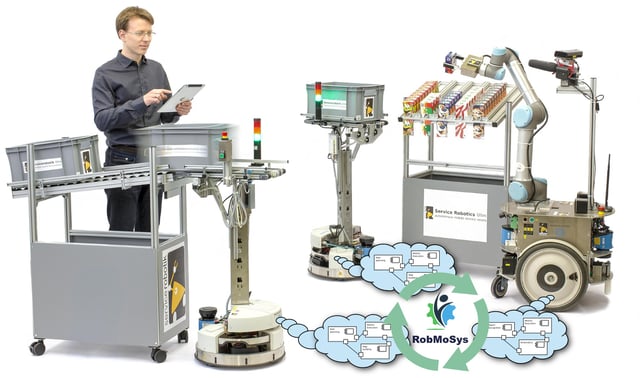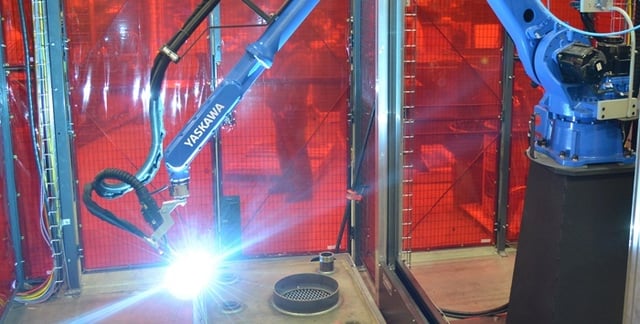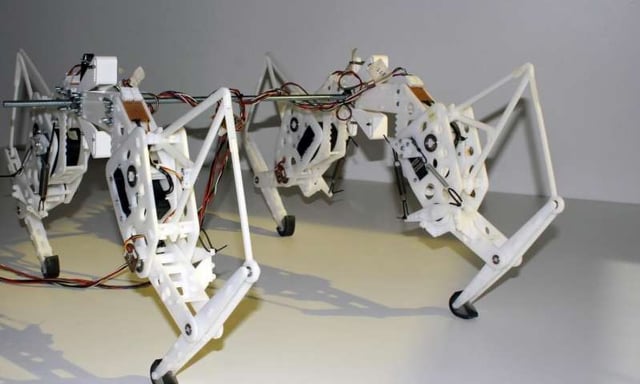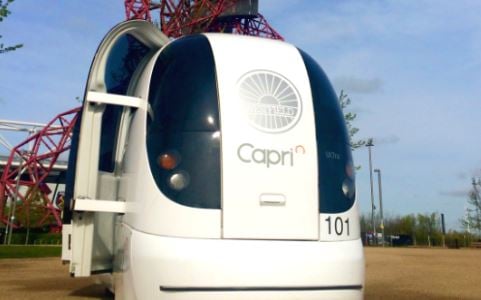What's New in Robotics This Week - Apr 21

Posted on Apr 21, 2017 7:00 AM. 11 min read time
Industrial & cobot roundup, meet the cheetah bot, drone brief (land & air), a good time to mention ISO/TS 15066, and much more. We hope that the news we have selected will interest and amuse you. Enjoy!
Industrial & Cobot Roundup
Robohub reported on RobMoSys (Composable Models for Robotics Systems) and ROSIN (ROS-Industrial quality-assured robot software components) --two industrial robotics projects being run as part of Horizon 2020.

RobMoSys, coordinated by the French Alternative Energies and Atomic Energy Commission, envisions a composition-oriented approach to system-of-system integration which is independent of the current code-centric robotic platforms, yet can build on top of them.
In order to consolidate Europe’s dominance in advanced manufacturing, the H2020 project ROSIN will push the role of the EU within ROS-Industrial to a leading position.
Thailand's Nation Multimedia reported on Universal Robots' plans in the country:
THAILAND should see increasing adoption of collaborative robots in response to intensifying competition locally and from neighbouring countries under the Asean Free Trade Area Agreement, according to Denmark-based Universal Robots.
Did you know that Thailand is the eighth largest market globally in the adoption of robotics? Imports of industrial robotics and automation systems exceeded US$47.3 million last year.

Over at Robotics Business Review, Phil Britt took a look at how welding robots can help with skilled worker shortages:
Last year, the American Welding Society (AWS) updated its forecast to an estimated shortage of 372,000 welders by 2026. Job search site Indeed listed nearly 9,000 open welder positions as of March.
The The Pittsburgh Post-Gazette reported on the ARM Institute's first membership recruitment meeting, which took place during National Robotics Week:
The staggering scale of the institute is appropriate for the challenge: how to use robotics to make American manufacturing more competitive with other countries while continuing to grow good-paying jobs. Wednesday’s opening session — the first public event since the grant was announced in January — gave prospective members an overview of how the massive group could benefit them.
Caption: Jay Douglass, chief operating officer of the ARM Institute, talks with Mayor Bill Peduto in Lawrenceville.
“Our mission, at a very high level, is establishing leadership in this area,” said Gary Fedder, interim CEO of the ARM Institute. “We want to lower the barrier for the companies to adopt this technology” while also “empowering the American worker” to find open positions.
Elsewhere, industrial robots with eyes make workers feel more comfortable, according to Quartz...
Rethink Robotics interviewed Gal Inbar, an entrepreneur and president of iCobots (Israeli Collaborative Robots), a factory automation company based near Tel Aviv.
Over at Big Think a philosopher warned that we are creating a world without consciousness...
And DigiTimes reported that Quanta Storage plans to showcase its TM5 robot at Hannover Messe 2017.
Meet the Robot Cheetah
The speed and efficiency of the cheetah has inspired roboticists from MIT to Boston Dynamics. Now Geert Folkertsma (a researcher at the University of Twente in the Netherlands) has created a prototype cheetah bot that could eventually improve four-legged bot's gait.
 Caption: The prototype Cheetah bot developed by Geert Folkertsma, University of Twente. (Via AlphaGalileo.)
Caption: The prototype Cheetah bot developed by Geert Folkertsma, University of Twente. (Via AlphaGalileo.)
ScienceDaily reports:
The prototype developed by Folkertsma weighs in at 2.5 kg and is 30 cm long: twenty times lighter than a real cheetah and four times smaller. Taking into account the weight difference, the robot moves using only about fifteen percent more energy than a real cheetah. The robot can currently reach a speed of about one kilometer per hour.
Drone Brief (Land & Air)
Apple received a permit to test self-driving cars in California.
The Verge reports:
According to the California DMV, Apple has three vehicles registered under the autonomous driving permit, all of which are 2015 Lexus RX crossovers. In addition, Apple has six drivers permitted to operate the vehicles. In the early days of its self-driving program, Google used Lexus SUVs outfitted with cameras and laser sensors.
General Motors announced that it will invest US$14 Million in its Cruise Automation research and development facility in San Francisco --a move that's expected to generate more than 1,000 jobs.
AUVSI reported that Britain is going to launch a STG4.2 million, government funded driverless vehicle trial in Bristol:

CAPRI, which is an automated vehicle consortium, is conducting the trial. Some of the members of the consortium include the South Gloucestershire Council, UWE and the University of Bristol.
If everything goes well with the trial, these vehicles, also referred to as pods, will be used to transport anyone that is visiting the Queen Elizabeth Olympic Park in east London, and the vehicles could possibly be licensed for use in other places.
In New Zealand, police used drones to bust an illegal cannabis crop. UK police have created an "anti-drone" squad to combat prison smugglers. John Podmore, former head of the UK prison service's anti-corruption unit responded by describing drone smuggling as a red herring.
According to Tokyo Reporter, a Japanese salesman was arrested following a collision involving Japan's first self-driving car.
Via GrindTV.
There's more to come in the regulatory space this month, by the way. On April 27th ,the US Federal Aviation Administration will release its first set of unmanned aircraft systems (UAS) facility maps.
The maps will "depict areas and altitudes near airports where UAS may operate safely. They will help drone operators improve the quality of their Part 107 airspace authorization requests and will help the FAA process these requests more quickly."
Michael Monnik, founder of drone-security service DroneSec, appeared on The Drone Show:
File our final story under "So Wrong, It's Right."
The viral robotics video of the week shows Michael Reeves, a student at Northern Arizona University who created a bot that uses facial recognition to shine a laser in his eyes.
There's a little swearing in there, which is understandable given the circumstances, so you've been warned.
There's also this gem, however: "Some people have compared this to like the invention of the PC or like the modern database, but I like to think of it more along the lines of The Second Wheel or like the invention of water."
"I really like the concept of object recognition and machine learning," Reeves told c|net. "And this method of computer vision uses a type of machine learning for object recognition, so it was perfect for me. But as for why I implemented it in a way that shines a laser into eyes, I can't be sure of what I was thinking."
We don't recommend programming robots to shine a laser in your eyes at home. Or at work. Or anywhere, for that matter.
Reeves doesn't either. Not anymore.
In case you're wondering, the errant roboticist did get through the process unharmed and triumphant. (He used a 5-MW laser diode and as you will see, doesn't let the laser linger on his pupils for any length of time.)
As Reeves told Digital Trends:
“I combined a multitude of useful technologies into one completely useless invention, as per my goal.”
This is probably a good time to mention Robotiq's guide to ISO/TS 15066.
There's nothing in there about shining lasers in people's eyes (sorry) but there is a whole lot of useful information about how to conduct safety assessments and set up a safe and secure human-cobot space.
I'll be back next week with more news from the world of robotics. Until then, I hope you enjoy these videos and links!
Quanta Storage to showcase TM5 robot at Hannover Messe 2017 (DigiTimes)
These surveillance robots will work together to chase down suspects (Recode)
Neural networks explained (Phys.Org)
ASU's Tom Sugar explores the next step in wearable robotics (Robotics Tomorrow)
Marsupial Robots Ain’t Cuddly, But They Are Totally Brilliant (Wired)
Police Robots Take On Brazil Drug Wars (Wall Street Journal)
How Germany’s Otto uses artificial intelligence (Economist)
Toyota’s Welwalk Robot Brace Helps Stroke Victims Walk Again (Robotics Trends)
This robot explains why you shouldn’t worry about artificial intelligence (MarketWatch)
Home Hunting for Collaborative Bots: Farm, Cloud, or Back Office? (Robotics Business Review)

 Caption: Jay Douglass, chief operating officer of the ARM Institute, talks with Mayor Bill Peduto in Lawrenceville.
Caption: Jay Douglass, chief operating officer of the ARM Institute, talks with Mayor Bill Peduto in Lawrenceville.






Leave a comment